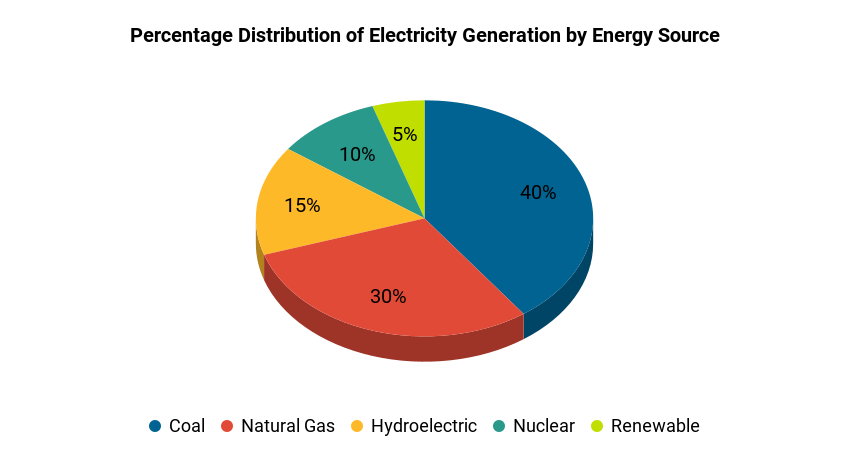- IELTS WRITING TASK 1
Percentage Distribution of Electricity Generation by Energy Source
You should spend about 20 minutes on this task.
The chart below presents information about the percentage distribution of energy sources used for electricity generation in a country.
Write a report of at least 150 words describing the information shown in the chart. Analyze the distribution of energy sources for electricity generation and discuss any implications or trends that emerge.

Sample Answer, C1 English Level, Advanced, Band Score 6.5-7.5
The provided chart displays the distribution of energy sources utilized for generating electricity in a specific country, presented as percentages. The largest segment, constituting 40%, comes from coal, indicating a significant reliance on this non-renewable source. Natural gas follows at 30%, suggesting its substantial contribution to the energy mix. Hydroelectric power contributes 15%, showcasing the utilization of water resources. Nuclear power generates 10% of the electricity, while renewable sources provide 5% of the total energy.
The chart reveals a notable dependence on fossil fuels, with coal and natural gas constituting the majority of the energy generation. The smaller portions allocated to hydroelectric, nuclear, and renewable sources imply a growing interest in cleaner energy alternatives.
In conclusion, the chart depicts the distribution of energy sources for electricity generation, emphasizing the need to diversify the energy mix to include more sustainable options. As the world focuses on environmental concerns, this data underscores the importance of transitioning towards greener and renewable energy sources to ensure a more sustainable future.
Essay:
The chart gives an overview of how electricity is produced in a certain country, showing the percentage breakdown of different energy sources. Coal accounts for the largest part, contributing 40% of the electricity. Natural gas comes next, making up 30%. Hydroelectric power provides 15%, while nuclear energy generates 10%. The remaining 5% comes from renewable sources.
From the chart, it’s evident that coal and natural gas are the primary sources of electricity, making up a significant portion of the energy mix. This indicates a reliance on non-renewable resources. However, it’s positive to see contributions from hydroelectric power, nuclear energy, and renewable sources, which are more environmentally friendly.
In conclusion, the chart highlights the various energy sources used for electricity generation. While coal and natural gas dominate, there’s a growing effort to incorporate cleaner and more sustainable alternatives like hydroelectric, nuclear, and renewables. This data reflects the ongoing transition towards a more environmentally conscious energy production.
Essay:
The presented chart provides insights into the composition of energy sources employed for generating electricity in a specific country. The data is presented as percentages, showcasing the various contributions. Notably, coal stands out as the primary energy source, contributing 40% of the electricity generation. Natural gas follows closely at 30%, indicating its substantial role in the energy mix.
Additionally, the chart reveals that hydroelectric power accounts for 15% of the electricity generation, showcasing the utilization of water resources for energy. Nuclear power plays a role as well, contributing 10% of the energy. Renewable sources, including solar, wind, and others, collectively provide 5% of the electricity.
The chart underscores the current energy landscape, with coal and natural gas dominating the mix. However, it’s promising to observe contributions from cleaner sources such as hydroelectric, nuclear, and renewables. This shift towards a more diversified and environmentally sustainable energy portfolio is crucial in addressing global energy challenges and environmental concerns.
In conclusion, the chart encapsulates the array of energy sources for electricity generation, reflecting the ongoing endeavor to strike a balance between meeting energy needs and mitigating environmental impacts.

